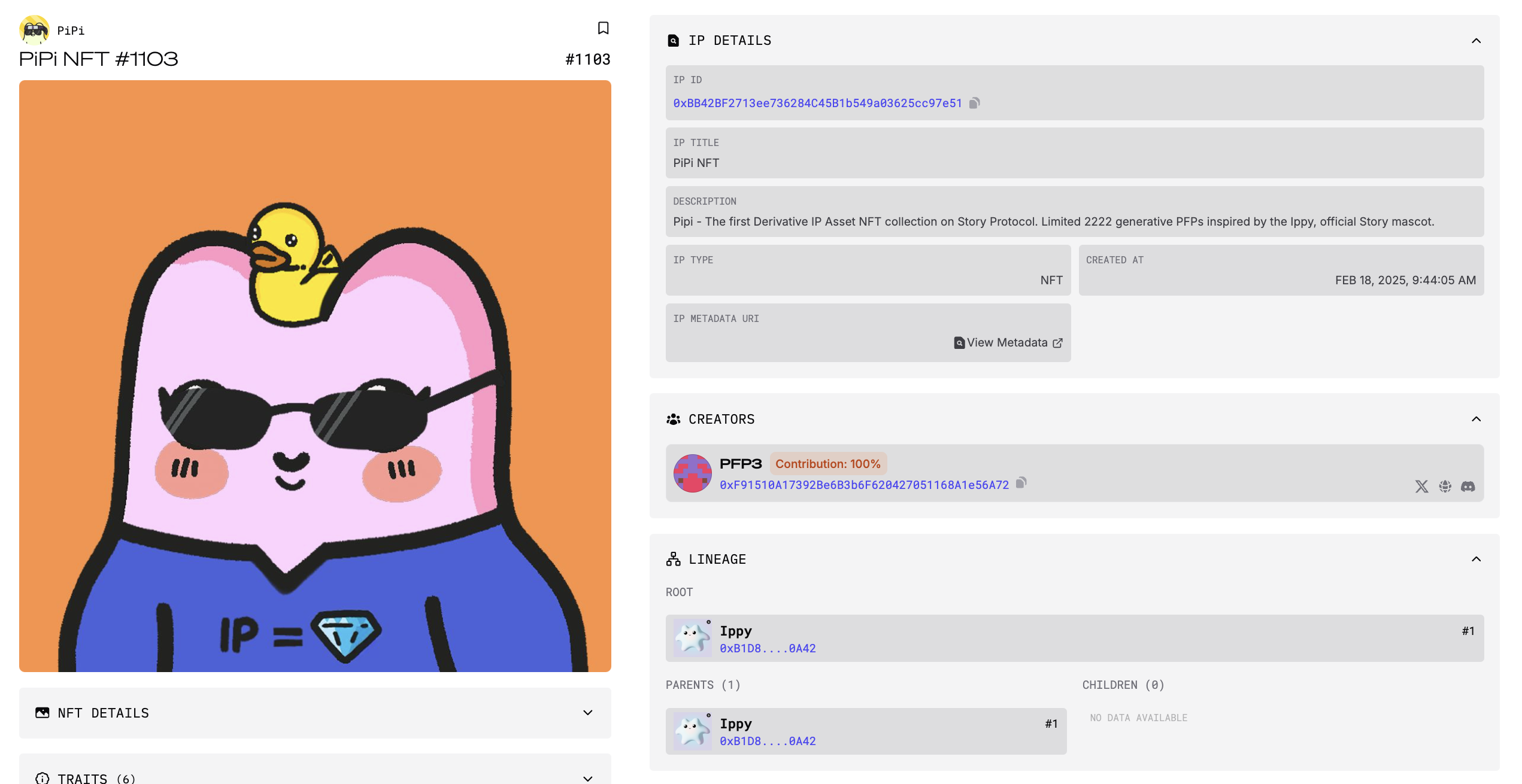PiPi is a free generative pfp project on Story that lets you mint derivative artworks of Ippy, Story’s official mascot. Ippy has Non-Commercial Social Remixing (NCSR) terms attached, which means anyone can use it or create derivative works as long as it’s not used commercially and proper attribution is shown.
When a PiPi is linked as a derivative of Ippy, it automatically inherits the same license terms (NCSR) and is linked in its ancestry graph, which you can see directly on our explorer:
In the bottom right, you can see Ippy is the root IP of this PiPi.
Prerequisites
There are a few steps you have to complete before you can start the tutorial.
- Complete the Setup Your Own Project
Before we register our new PiPi IP, we need to set up its metadata. There are two types of metadata:
- NFT Metadata
- IP Metadata
Using this PiPi as an example, here is what the NFT & IP metadata should be:
{
"name": "PiPi NFT #1103",
"image": "https://ipfs.io/ipfs/bafybeigsv4cgacndijwy6b7qhxbseonrybrcpbh47zrlm64gsjm4mlpb2q/nft_1103.jpeg",
"attributes": [
{
"trait_type": "Bg",
"value": "Orange"
},
{
"trait_type": "Body",
"value": "Pink"
},
{
"trait_type": "Eyes",
"value": "Cute"
},
{
"trait_type": "Cloth",
"value": "Blue"
},
{
"trait_type": "Glasses",
"value": "Neo"
},
{
"trait_type": "Hat",
"value": "Duck"
}
],
"description": "Pipi - The first Derivative IP Asset NFT collection on Story Protocol. Limited 2222 generative PFPs inspired by the Ippy, official Story mascot."
}
2. Minting an NFT
When you want to register an IP on Story, you must first mint an NFT. This NFT represents the ownership over the IP Asset.
Here is part of the _mintNFT function in the PiPi.sol contract:
contract PiPi is ERC721, Ownable, IERC721Receiver {
// ... some code here ...
function whitelistMint() external payable returns (string memory, address) {
require(whitelistMintEnabled, "Whitelist mint is not active");
require(whitelist[msg.sender], "Address not whitelisted");
require(mintedCount[msg.sender] < WHITELIST_MAX_P_WALLET, "Whitelist mint limit reached");
require(_totalSupply < MAX_SUPPLY, "Max supply reached");
return _mintNFT(msg.sender);
}
function _mintNFT(address recipient) internal returns (string memory, address) {
uint256 newTokenId = _totalSupply + 1;
_safeMint(address(this), newTokenId);
address ipId = _registerAsIPAsset(newTokenId);
string memory nftUri = tokenURI(newTokenId);
bytes32 metadataHash = keccak256(abi.encodePacked(nftUri));
CORE_METADATA_MODULE.setAll(ipId, nftUri, metadataHash, metadataHash);
registerDerivativeForToken(ipId);
_safeTransfer(address(this), recipient, newTokenId, "");
// ... more code here ...
return (nftUri, ipId);
}
}
whitelistMint which then calls _mintNFT after checking if the user is on a whitelist. On line 16, we are then minting a new NFT to the contract.
Why do we mint an NFT to the contract and not the user?We later have to register the IP as a derivative of Ippy. Only the owner (the address holding the NFT) can register an IP as a derivative of another. So, we will mint the NFT to the contract => contract registers NFT as IP and then later as a derivative of Ippy => transfer NFT to the user.
3. Registering NFT as IP
Once we have minted a new NFT, we can register it as IP. On line 18 above, it calls a _registerAsIPAsset function:
function _registerAsIPAsset(uint256 tokenId) internal returns (address) {
try IP_ASSET_REGISTRY.register(block.chainid, address(this), tokenId) returns (address ipId) {
require(ipId != address(0), "IP Asset registration failed");
return ipId;
} catch Error(string memory reason) {
revert(reason);
} catch {
revert("IP Asset registration failed");
}
}
register function on the IP Asset Registry, which creates a new IP Asset in our protocol, and returns an ipId.
Now that we have registered a new IP Asset, we can take our metadata from before and set it on the NFT & IP with the CoreMetadataModule.sol. As described here, we need to set 4 params:
nftMetadataHashnftMetadataURIipMetadataHashipMetadataURI
// handles the NFT's `nftMetadataHash`
// handles the IP's `ipMetadataURI` and `ipMetadataHash`
function _mintNFT(address recipient) internal returns (string memory, address) {
// ... some code here ...
string memory nftUri = tokenURI(newTokenId);
bytes32 metadataHash = keccak256(abi.encodePacked(nftUri));
CORE_METADATA_MODULE.setAll(ipId, nftUri, metadataHash, metadataHash);
// ... some code here ...
}
// handles the NFT's `nftMetadataURI`
function tokenURI(uint256 tokenId) public view override returns (string memory) {
return string(abi.encodePacked(_baseUri, StringUtils.uint2str(tokenId), ".json"));
}
5. Register as Derivative
Now that we have minted an NFT, registered it as IP, and set proper metadata, we can register it as a derivative of Ippy. The PiPi.sol contract uses registerDerivativeForToken to handle this:
function registerDerivativeForToken(address ipId) internal {
address[] memory parentIpIds = new address[](1);
parentIpIds[0] = 0xB1D831271A68Db5c18c8F0B69327446f7C8D0A42;
uint256[] memory licenseTermsIds = new uint256[](1);
licenseTermsIds[0] = 1;
address licenseTemplate = 0x2E896b0b2Fdb7457499B56AAaA4AE55BCB4Cd316;
bytes memory royaltyContext = hex"0000000000000000000000000000000000000000";
uint256 maxMintingFee = 0;
uint32 maxRts = 0;
uint32 maxRevenueShare = 0;
LICENSING_MODULE.registerDerivative(
ipId,
parentIpIds,
licenseTermsIds,
licenseTemplate,
royaltyContext,
maxMintingFee,
maxRts,
maxRevenueShare
);
}
registerDerivative in the Licensing Module, with:
ipId: the new ipId we got in step 3parentIpIds: an array that contains Ippy’s ipId, which is 0xB1D831271A68Db5c18c8F0B69327446f7C8D0A42licenseTermsIds: an array containing 1, which is the license term ID of Non-Commercial Social Remixing (NCSR). This means the derivative can use Ippy for free but not commercialize itlicenseTemplate: the address of PILicenseTemplate, found in Deployed Smart ContractsroyaltyContext: just set to zero addressmaxMintingFee, maxRts, and maxRevenueShare can be set to 0. They don’t do anything because the license terms are non-commercial.
6. Transfer NFT
Now that the contract has handled registering the IP as a derivative, it transfers the NFT to the user to have ownership over the PiPi IP:
function _mintNFT(address recipient) internal returns (string memory, address) {
// ... some code here ...
_safeTransfer(address(this), recipient, newTokenId, "");
// ... some code here ...
}
7. Done!
Congratulations, you registered a derivative of the official Ippy IP!


